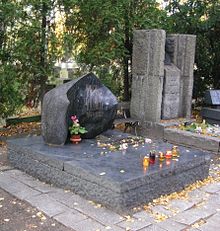| Revision as of 23:06, 29 April 2006 editYurikBot (talk | contribs)278,165 editsm robot Adding: sv:Wola← Previous edit | Revision as of 22:57, 7 November 2006 edit undo213.158.197.37 (talk) →HistoryNext edit → | ||
| Line 23: | Line 23: | ||
| The Wola district later became famous for the Polish Army's defence of Warsaw in ] during the ] and in ] during the ], when ] and ] defended the city against tsarist forces. | The Wola district later became famous for the Polish Army's defence of Warsaw in ] during the ] and in ] during the ], when ] and ] defended the city against tsarist forces. | ||
| During the ] (August-October ]), fierce battles raged in Wola. Around ], Wola was the scene of the largest single massacre of (according to different sources) 40,000 to 50,000 of the Polish population. The |
During the ] (August-October ]), fierce battles raged in Wola. Around ], Wola was the scene of the largest single massacre of (according to different sources) 40,000 to 50,000 of the Polish population. The German units indiscriminately executed the civilians of the district, including hospital patients, elderly, children and women, as well as any insurgents taken prisoner. | ||
| ], ]]] | ], ]]] | ||
Revision as of 22:57, 7 November 2006
Wola is a district of western Warsaw, Poland, formerly the village of Wielka Wola, that was incorporated into Warsaw in 1916. An industrial area with traditions reaching back to the early 19th century, it's slowly changing into an office and residential district. Several museums are located in Wola.

History
Mentioned in texts of the 14th century, it became the site of the free elections, from 1573 to 1764, of Poland's kings by the szlachta (nobility) of the Polish-Lithuanian Commonwealth.
The Wola district later became famous for the Polish Army's defence of Warsaw in 1794 during the Kościuszko Uprising and in 1831 during the November Uprising, when Józef Sowiński and Józef Bem defended the city against tsarist forces.
During the Warsaw Uprising (August-October 1944), fierce battles raged in Wola. Around August 8, Wola was the scene of the largest single massacre of (according to different sources) 40,000 to 50,000 of the Polish population. The German units indiscriminately executed the civilians of the district, including hospital patients, elderly, children and women, as well as any insurgents taken prisoner.
To quote Martin Gilbert, in his The Second World War: A Complete History, page 565, (see Google Books page view):
- By August 5, more than fifteen thousand Polish civilians had been murdered by German troops in Warsaw. At 5:30 that evening, General von dem Bach Zelewski gave the order for the execution of women and children to stop. But the killing continued of all Polish men who were captured, without anyone bothering to find out whether they were insurgents or not. Nor did either the Cossacks or the criminals in the Kaminsky and Dirlewanger brigades pay any attention to von dem Bach Zelewski's order: by rape, murder, torture and fire, they made their way through the suburbs of Wola and Ochota, killing in three days of slaughter a further thirty thousand civilians, including hundreds of patients in each of the hospitals in their path.
The mass murder of civilians in Wola district was investigated by Central Commission for Investigation of German Crimes in Poland.

External links
- Witness testimony on German massacre of Polish hospital patients
- Witness testimony on German massacre of Polish civilians in Wola
This Warsaw-related location article is a stub. You can help Misplaced Pages by expanding it. |
| Inner city districts |
| ||||||||||||||||||||||
|---|---|---|---|---|---|---|---|---|---|---|---|---|---|---|---|---|---|---|---|---|---|---|---|
| Outer city districts |
| ||||||||||||||||||||||
| Related | |||||||||||||||||||||||